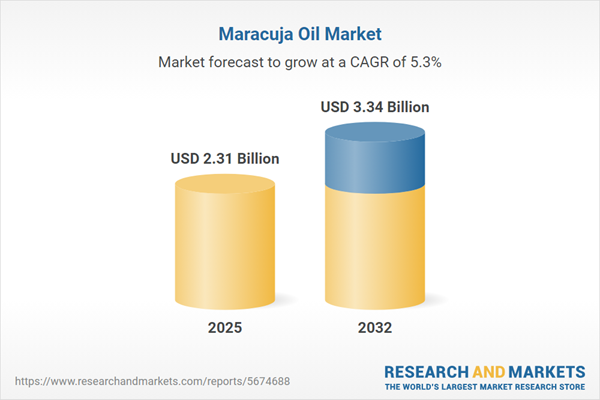Speak directly to the analyst to clarify any post sales queries you may have.
The maracuja oil market is experiencing significant transformation, shaped by a focus on transparency, digital adoption, and evolving supplier approaches. As industry dynamics shift, executive teams are prioritizing streamlined processes and strategic agility to access upcoming opportunities and ensure sustained value creation.
Market Snapshot: Maracuja Oil Market Size and Growth
In 2024, the global maracuja oil market achieved a value of USD 2.20 billion, registering a compound annual growth rate (CAGR) of 5.34%. The market is on track for steady, incremental growth, with projections indicating a rise to USD 2.31 billion in 2025 and USD 3.34 billion by 2032. This trajectory is anchored by strong demand across personal care, food, wellness, and pharmaceutical sectors. Market participants are expanding product diversity and deepening collaborations, alongside operational improvements, to better anticipate client requirements and invest in high-potential market segments.
Scope & Segmentation: Strategic Insights for Decision-Makers
Gaining a nuanced understanding of the maracuja oil market allows senior leaders to drive growth while managing operational risk across a dynamic business environment. Targeted segmentation is integral, as each segment presents unique operational priorities and regulatory demands, supporting resilient, long-term strategies. Sector leaders are responding with tailored approaches designed to optimize resource allocation and market fit.
- Product Types: Cold pressed maracuja oil resonates with companies prioritizing authentic, minimally processed offerings, whereas refined variants appeal to large-scale businesses demanding product consistency and enhanced processing performance.
- Applications: Maracuja oil’s key uses span dietary supplements, cosmetics, pharmaceuticals, and innovative food products, enabling manufacturers to address diverse customer requirements and tap into multiple value streams.
- Distribution Channels: Market access is achieved via e-commerce platforms, traditional retailers, beauty specialists, and pharmacies, positioning suppliers closer to evolving consumer habits and enabling wide-scale product deployment.
- End Users: The market serves manufacturers of cosmetics, dietary supplements, pharmaceuticals, and personal care items, underlining the oil’s value as a high-quality ingredient in comprehensive wellness and personal care solutions.
- Regions: Strategic initiatives must reflect regulatory and consumer specifics in the Americas, Europe, the Middle East, Africa, and Asia-Pacific. Adapting to local standards and consumer trends supports seamless market integration.
- Technologies: Critical advancements—such as supercritical CO₂ extraction—enhance product quality and open opportunities for niche customization, with technology adoption emerging as a key enabler of differentiation and scalability.
- Leading Companies: Industry progress is driven by key players including Givaudan SA, Symrise AG, International Flavors & Fragrances Inc., Firmenich International SA, doTERRA International LLC, Young Living Essential Oils LC, NOW Foods LLC, Biolandes SAS, Koster Keunen Inc., and Weleda AG, who continually refine efficiency and innovation efforts to maintain a competitive edge.
Key Takeaways for Senior Decision-Makers
- Strengthening supplier partnerships increases operational flexibility and supports resilience in response to external supply chain challenges.
- Implementing advanced extraction methods ensures stable product quality and enables rapid adaptation to evolving requirements in client portfolios.
- Diversifying across both digital and in-store distribution drives broader reach and supports iterative refinement through real-time, diverse client input.
- Focusing on transparent sourcing and minimal processing meets stakeholder expectations around traceability, building trust and credibility in established and developing markets.
- Crafting flexible compliance approaches ensures streamlined entry into new regulatory environments and minimizes integration delays for international expansion.
- Enabling collaboration between sourcing, regulatory, and quality management drive responsiveness and support ongoing process enhancements.
Tariff Impact on the Global Maracuja Oil Market
Anticipated tariff changes in the United States in 2025 are expected to influence global trade flows within the maracuja oil sector. Companies are adapting their supply strategies, integrating value chain operations, and using compliance automation to mitigate regulatory risks and maintain steady operations during periods of regulatory adjustment.
Methodology & Data Sources
This assessment is grounded in executive interviews, regulatory expert consultation, detailed secondary research, and expert review, resulting in a market analysis that supports informed, actionable decisions for maracuja oil stakeholders.
Why This Report Matters: Maracuja Oil Market
- Empowers leadership to leverage the latest extraction techniques and compliance practices for stronger, data-driven strategy development.
- Offers clear segmentation analysis, guiding investments toward segments and regions with the highest strategic relevance and potential ROI.
- Enables confident market entry and expansion through practical intelligence on emerging risks, changing regulation, and shifting supply landscapes.
Conclusion
Organizations prioritizing agile sourcing, scalable partnerships, and compliance alignment are better positioned for reliable growth. Dynamic, data-oriented strategies will enhance resilience and strengthen market standing as global industry conditions progress.
Additional Product Information:
- Purchase of this report includes 1 year online access with quarterly updates.
- This report can be updated on request. Please contact our Customer Experience team using the Ask a Question widget on our website.
Table of Contents
3. Executive Summary
4. Market Overview
7. Cumulative Impact of Artificial Intelligence 2025
Companies Mentioned
The companies profiled in this Maracuja Oil market report include:- Givaudan SA
- Symrise AG
- International Flavors & Fragrances Inc.
- Firmenich International SA
- doTERRA International LLC
- Young Living Essential Oils, LC
- NOW Foods, LLC
- Biolandes SAS
- Koster Keunen, Inc.
- Weleda AG
Table Information
| Report Attribute | Details |
|---|---|
| No. of Pages | 186 |
| Published | October 2025 |
| Forecast Period | 2025 - 2032 |
| Estimated Market Value ( USD | $ 2.31 Billion |
| Forecasted Market Value ( USD | $ 3.34 Billion |
| Compound Annual Growth Rate | 5.3% |
| Regions Covered | Global |
| No. of Companies Mentioned | 11 |









